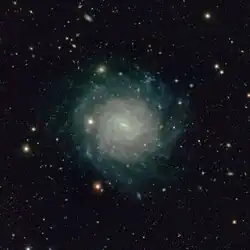| NGC 101 | |
|---|---|
 ESO KIDS image of NGC 101 | |
| Observation data (J2000 epoch) | |
| Constellation | Sculptor |
| Right ascension | 00h 23m 54.614s |
| Declination | −32° 32′ 10.34″[1] |
| Redshift | 0.011284[1] |
| Heliocentric radial velocity | 3383[1] |
| Distance | 149.8 Mly (45.92 Mpc)[2] |
| Apparent magnitude (V) | 12.84[1] |
| Apparent magnitude (B) | 13.36[3] |
| Characteristics | |
| Type | SAB(rs)cd:[1] |
| Size | 119,200 ly (36,560 pc)[1][note 1] |
| Apparent size (V) | 2.2′ × 2.0′[1] |
| Other designations | |
| MGC-05-02-003, PGC 1518[3] | |
NGC 101 is a spiral galaxy estimated to be about 150 million light-years away in the constellation of Sculptor. It was discovered by John Herschel in 1834 and its magnitude is 12.8.[4] It is a member of the Southern Supercluster (also called the Laniakea Supercluster) the closest galaxy supercluster to the Local Supercluster.[5]
Notes

NGC 101 (2MASS)
References
- 1 2 3 4 5 6 7 "NED results for object NGC 0101". National Aeronautics and Space Administration / Infrared Processing and Analysis Center. Retrieved 11 March 2017.
- ↑ Iglesias-Páramo, J.; et al. (2006). "Star Formation in the Nearby Universe: The Ultraviolet and Infrared Points of View". The Astrophysical Journal Supplement Series. 164 (1): 38–51. arXiv:astro-ph/0601235. Bibcode:2006ApJS..164...38I. doi:10.1086/502628. S2CID 17135800.
- 1 2 "NGC 101". SIMBAD. Centre de données astronomiques de Strasbourg. Retrieved 11 March 2017.
- ↑ "NGC Objects: NGC 100 - 149".
- ↑ Shyamal (October 1989). "The Southern Supercluster". Astronomical Journal. 98: 1175–1187. Bibcode:1989AJ.....98.1175M. doi:10.1086/115205. Retrieved 19 November 2020.
External links
 Media related to NGC 101 at Wikimedia Commons
Media related to NGC 101 at Wikimedia Commons
This article is issued from Wikipedia. The text is licensed under Creative Commons - Attribution - Sharealike. Additional terms may apply for the media files.